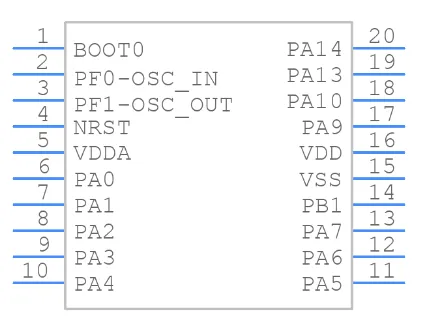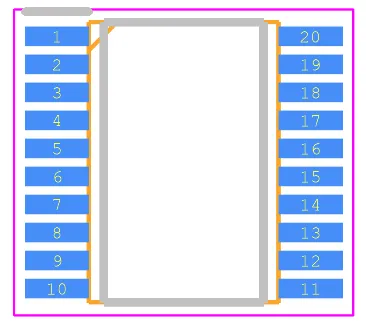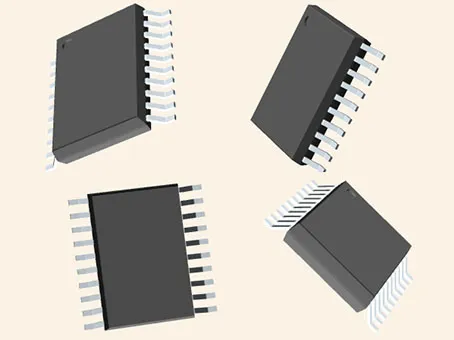STM32F030F4P6 Microcontroller: Overview, Applications, and Datasheet
STM32F030F4P6
Product Overview
Part Number: STM32F030F4P6
Manufacturer: STMicroelectronics
Description: 32-Bit Single-Core 48MHz ARM® Cortex®-M0 STM32F0 Microcontroller IC 16KB (16K x 8 FLASH)
Lead Time: Can Ship Immediately
Datasheet: Datasheet PDF
Category: Integrated Circuits (ICs), Embedded, Microcontrollers
Number of Pins: 20
Short Description
In addition to the high-performance Arm® Cortex®-M0 32-bit RISC core operating at 48 MHz, STM32F030x4/x6/x8/xC microcontrollers incorporate a wide array of enhanced peripherals and I/Os, as well as high-speed embedded memory (256 Kbytes of Flash memory and 32 Kbytes of SRAM). On all devices, there is a 12-bit ADC, seven general-purpose 16-bit timers, and a PWM timer with advanced control. A total of six USARTs and two I2Cs are also included.
In addition to operating between -40 and +85°C, the STM32F030F4P6 microcontroller can be powered by a 2.4 to 3.6V power supply. Power-saving options make it possible to design low-power applications. A wide range of pin counts is available with the STM32F030F4P6 microcontrollers. Each device includes different peripherals. STM32F030F4P6 peripherals are described in the following description.
With a microcontroller such as the STM32F030F4P6, you are able to control applications and interact with users, as well as handheld equipment, digital television, computer peripherals, gaming, GPS platforms, industrial applications, PLCs, inverters, printers, scanners, alarm systems, video intercom systems, and HVAC systems.
Product Technical Specifications
STM32F030F4P6 Design
CAD Model
STM32F030F4P6 Symbol
STM32F030F4P6 Footprint
STM32F030F4P6 3D Model
STM32F030F4P6 Microcontroller Features
A microcontroller from STMicroelectronics, the STM32F030F4P6, is one of its STM32F0 series. A detailed description of its features can be found here:
Core: A 32-bit, low-power ARM Cortex-M0 processor core is used to power the STM32F030F4P6 microcontroller. As a result of their high efficiency and performance, Cortex-M0 cores are well suited for embedded applications.
Clock Speed: As an embedded processor, it provides sufficient processing power for a variety of embedded applications, running at a maximum clock speed of up to 48 MHz.
Memory: A 16KB Flash memory and a 4KB SRAM memory store programs and data respectively on the microcontroller. Complex firmware and data processing tasks can be implemented with this memory configuration.
Peripherals: Among the built-in peripherals of the STM32F030F4P6 microcontroller are GPIO (General Purpose Input/Output), USART (Universal Synchronous/Asynchronous Receiver/Transmitter) interface, SPI (Serial Peripheral Interface) ports, I2C (Inter-Integrated Circuit) interfaces, timers, and ADC (Analog-to-Digital Converter). Interfacing with external devices, communicating with other devices, and acquiring data are all performed using these peripherals.
Analog-to-Digital Converter (ADC): Sensor inputs and other analog signals are accurately converted to digital by the microcontroller's 12-bit ADC with up to 10 channels.
Timers: This processor contains multiple timers, including PWM timers able to measure time intervals, generate pulse width modulation signals, and control external devices.
Communication Interfaces: In order to communicate with external devices, such as sensors, displays, and other microcontrollers, the microcontroller supports a variety of communication interfaces, including USART, SPI, and I2C.
Low-Power Features: Battery-powered and energy-efficient applications can take advantage of the low-power modes in the STM32F030F4P6 microcontroller. These modes include Sleep, Stop, and Standby.
Operating Voltage: It is suitable for low-voltage and battery-powered applications, operating between 2.0V and 3.6V.
Package: A wide variety of package options are available, including LQFP (Low-Profile Quad Flat Package) and TSSOP (Thin Shrink Small Outline Package). These packages give board designers and integrators more flexibility.
Security Features: Secure booting, memory protection, and hardware encryption are all methods used by microcontrollers to secure sensitive data and firmware.
Temperature Range: In harsh industrial settings and environmental conditions, it can operate at temperatures between -40°C and +85°C.
Similar Specs Components
Here in this section, we compared the different components which have the similar species with the STM32F030F4P6 Microcontroller component. Please feel free to let us know in the comment section if we missed any important points you think we should have included.
STM32F030F4P6 Applications
Various devices and systems within a home can be controlled remotely and automatically using a smart home automation system. A variety of functions can be enabled by the STM32F030F4P6 microcontroller in such a system:
Device Control: Sensors and actuators throughout the house can interface with the microcontroller, including temperature sensors, motion sensors, light sensors, relays, and motor controllers. Actuators are used to adjust settings when the environment changes, based on the information collected by sensors.
Home Monitoring: In addition to monitoring environmental parameters, microcontrollers can measure humidity levels and temperature. Door/window sensors and motion sensors can also be used to detect motion or intrusion.
Energy Management: Based on temperature and occupancy data, the microcontroller can optimize HVAC use within the home. Lighting systems can be controlled based on the level of ambient light and occupancy by increasing or decreasing brightness levels or turning on/off lights as needed.
Security System Integration: A home security system can be controlled by the STM32F030F4P6 microcontroller. Security cameras and motion detectors can be integrated into the device to detect and respond to possible threats. In case of unauthorized access or suspicious activity, it can also trigger alarms or notify homeowners.
User Interface: To control and monitor your smart home system, you can connect the microcontroller to buttons, keypads, and touchscreens. The LCD display or a mobile app can be used to show system status, sensor readings, and alerts.
Wireless Communication: Wireless communication is provided by the microcontroller's built-in USART or SPI interface, which enables it to connect with Wi-Fi routers, Zigbee hubs, or Bluetooth-enabled devices. Data from sensors, system status, and control commands can be received by a remote monitoring station.
Automation Logic: Automating routine tasks within the home can be accomplished with the STM32F030F4P6 microcontroller. This system is capable of scheduling events, initiating actions, and responding to changes in the environment for enhanced comfort, convenience, and energy efficiency.
Remote Access and Control: The smart home system can be easily accessed and controlled remotely thanks to the microcontroller's low-power operation and wireless communication capabilities. Mobile apps and web interfaces allow homeowners to adjust settings, monitor and control their devices remotely.
Various home systems and devices can be intelligently controlled, monitored, and automated using the STM32F030F4P6 microcontroller. Smart home solutions that improve comfort, security, and energy efficiency for homeowners are possible because of its versatility, low power consumption, and integrated features.
Faqs
Question 1: Are STM32F030F4P6 microcontrollers battery-operated?
Answer: There are low-power modes and battery-powered modes on the STM32F030F4P6 microcontroller, which makes it suitable for battery-powered applications or energy-efficient application design.
Question 2: STM32F030F4P6 Development Boards: What are they?
Answer: Providing a convenient prototyping and development platform for the STM32F030F4P6 microcontroller, STMicroelectronics offers development boards and evaluation kits.
Question 3: How to do STM32F030F4P6 subtle delay?
Answer: For subtle delays, it is necessary to use a timer. The frequency of F030 is 48M. By dividing the frequency by 48, the period is 1 microsecond, and the frequency is 1 MHz. This pulse should be recorded using the timer. After 10 times of recording, it will be generated with a delay of 10us. A 10us delay can be achieved by interrupting.
Wrapping Up
A wide range of embedded applications can benefit from the STM32F030F4P6 microcontroller from STMicroelectronics. In addition to running at 48 MHz with an ARM Cortex-M0 core, the STM32F030F4P6 microcontroller provides developers with a wide range of peripherals, such as ADCs, USARTs, SPIs, and I2C interfaces, along with ample Flash and SRAM memory.
Battery-powered devices, IoT applications, sensor nodes, industrial control systems, and consumer electronics can all benefit from its low-power, extensive development ecosystem, and support for real-time applications. A comprehensive set of development tools, libraries, and documentation is also included in the STM32F030F4P6 microcontroller.
Featuring impressive performance, power efficiency, and scalability, the STM32F030F4P6 is a reliable and feature-rich microcontroller. A wide range of embedded applications, from simple sensor interfaces to complex IoT devices, can be handled with its robust features, coupled with STMicroelectronics' commitment to innovation and customer support.
STM32F407IGT6 Microcontroller: Features, Applications and Datasheet
Comparing FPGA vs Microcontroller: Optimal for Your Needs?
Differences Between FPGA vs Microcontroller
STM8S005K6T6C Microcontroller: Features, Apps & Datasheet Insights
ATMega328P Microcontroller: A Powerful Microcontroller
Carbon Film vs Metal Film Resistor
How to Test a Hard Start Capacitor [Complete Guide]
Unveiling Polypropylene Capacitors: Principles, Applications, and Future Trends
Comparative Analysis of DC Transmission and AC Power
Semaphore in Embedded System













